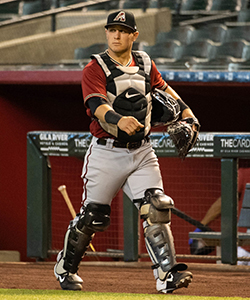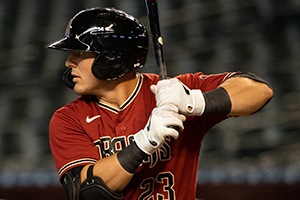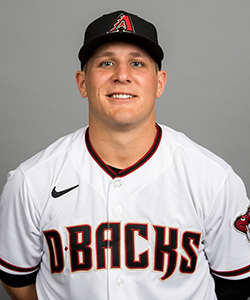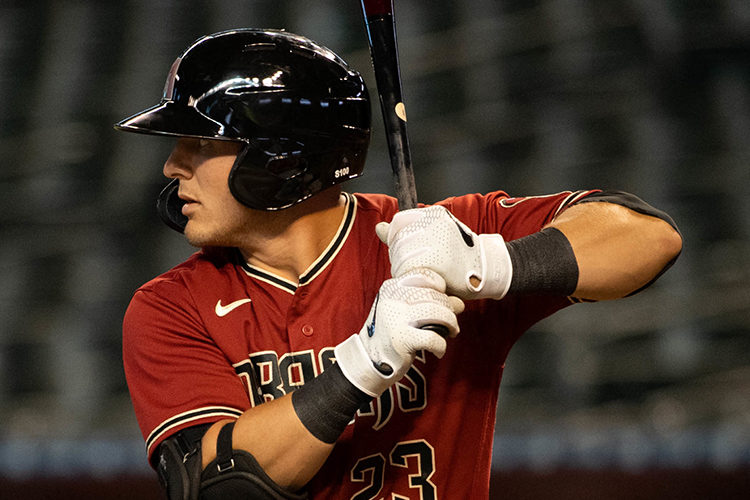Scott Doffek was looking for the proverbial needle in a haystack as he watched dozens of players throw, catch, run and hit at a baseball showcase event in the summer of 2013 at The Rock in Franklin. The UW-Milwaukee coach was evaluating potential recruits and hoping to identify a special talent or two.
As he scoured the field, “trying to watch 100 different kids do 100 different things at once,” Doffek kept coming back to one player.
He was a catcher who stood 5-foot-6, tops, and didn’t remind anyone of Ted Williams at the plate or Johnny Bench behind it.
“He was undersized,” Doffek remembers. “He was a little awkward. He had kind of a high-maintenance stance and not a great arm action, so there’s some things where you’re going, ‘Well, I’m not so sure.’”
But the more Doffek watched Daulton Varsho, then a rising senior at Marshfield High School, the more the other players faded into the background. There was something about this kid. He played so hard, with so much grit and passion. But more than that, his instincts were off the charts. He was always in the right place, always making the right play, and doing it faster and better than everyone else.

“Those are the things that are actually hard to find,” Doffek says. “The skill-set stuff – a guy can run and throw and he’s got some power and size and strength – those things are all fairly easy to measure. But those instinctual attributes and acumen for the game is so hard to find.
“Really, you have to be around a baseball player quite a bit to see some of those things. But it happens pretty fast when you watch Daulton play. I can coach my whole career and I’m not going to find somebody that has better baseball instincts. It’s really that simple.”
Varsho, the son of Marshfield native Gary Varsho, who played parts of eight seasons in the major leagues, wanted to play college baseball close to home so his parents could attend his games, and found Milwaukee to be the perfect fit. And anyway, he didn’t have many other compelling options.
“I was not highly recruited,” he says. “The only Division I schools that wanted me were UWM and Bradley. The rest were Division II and Division III schools in Wisconsin and a couple Division IIs in Minnesota. Realistically, nobody wanted me enough.”
Second round pick
Their loss was Milwaukee’s gain. After three stellar seasons with the Panthers, Varsho was selected by Arizona in the second round (the 68th pick overall) of the 2017 Major-League Baseball Draft, ascended rapidly through the Diamondbacks’ farm system and made his major-league debut on July 30, 2020.
He thus became the first-ever UWM player to make it to the big leagues.
“This was such a weird year,” Varsho says, referring to the pandemic-shortened season and games played without fans in the stands. “I never would have thought I would make my debut and my parents and my family and my girlfriend wouldn’t be there for it. It was a wild year. It was fun, though. I learned so much this year, just being able to take that all in in such a short span of time.”
Varsho played in 37 games for the Diamondbacks, starting 13 in center field and six behind the plate. He also got five starts in left field and five as the designated hitter. He hit .188 in 101 at-bats, scored 16 runs and had three homers, five doubles, two triples and nine RBI.

The D-Backs covet his versatility, so much so that he’s taken grounders at second and third base.
“This year, I was blessed to be able to go out there and play center field and a little bit of left,” Varsho says. “I think I can do really good out there. I think I could be a Gold Glover. It’s going to take me some more games to understand footwork and technique, but I think I could really hold that down for the D-Backs in the future. I just hope they give me a chance.
“But I’m not going to give up catching. Catching has been my love and I think that’s what makes me so valuable, is I can go and catch behind the dish and I can also play center field at an elite level.”
Says Doffek, “Whether he catches in the big leagues or he plays center field or left field, or they move him to second or third or whatever, he’s just a baseball player. I mean, he’s not going to play shortstop and he’s not going to play first base, but he could fake it anywhere else and figure it out and be very, very good at the position.”
Dad played in majors
Varsho’s baseball education began at a very young age. He got to hang around major-league clubhouses as his father played a total of 571 games for the Cubs, Pirates, Reds and Phillies from 1988 to 1995. He saw how professionals went about the game, how they practiced, how they prepared, how they handled streaks and slumps.
“I was around Jim Thome, Chase Utley, Jimmy Rollins, Shane Victorino, Kenny Lofton,” Varsho says. “It was an unreal experience. Being able to soak that in at such a young age, see their routines and what they did, I think that helped me see what it took to stay in the big leagues. … It was a cool opportunity to be able to do those things and meet the people I met, and I just cherish those moments in my life.”

By the time he got to UWM in the fall of 2014, he was so far ahead of the developmental curve that he turned heads even in the first few days of practice. He may have been an 18-year-old freshman, but he played as if he’d been around the game forever. He knew how to handle pitchers, moved behind the plate like a pro and ran the bases with his hair on fire. And the ball exploded off his bat.
“I can remember fall of his freshman year,” Doffek says. “We were doing just a short toss drill. We weren’t even taking a stride; we were just really using our back half and hands and the guy was hitting – with a wood bat – balls off our scoreboard as an 18-year-old kid who was 5-6 or 5-7. I was like, ‘Holy cow, that doesn’t even make sense.’
“He’s got a tremendous amount of bat speed but more than that, he just gets so connected at contact. There’s so much leverage. And he has exceptional hand strength. I think if you look at some of the best hitters in the course of history, you’ll notice there’s hand strength involved.”
During an intra-squad game that fall, Varsho faced 6-foot-7 right-hander Mason Pingel, a graduate student who’d pitched at Western Illinois, where he struck out 54 batters in 54.1 innings and in 2013 beat then-No. 1 Arkansas.
“I had two strikes on him,” Pingel recalls. “I threw a changeup and he fouled it off. It seemed like he was on it, so then I threw a fastball for a ball outside. When I let it go, I thought, ‘There’s no way he’s going to hit that.’ And he laced it for a double like it was nothing. I thought, ‘OK, this guy is better than me.’”
Oppposing coach checks bat
No one who was around the program in the spring of 2016 will ever forget the season-opening series at No. 25 Texas Tech. Varsho, a sophomore, hit an opposite-field homer in the first game, a scorching line drive that left the park in a hurry.
The Texas Tech coach sprang from the dugout, talked to the umpire and asked for Varsho’s bat, which he wanted to send to the NCAA to be tested. He’d never seen such opposite-field power, especially from a player of Varsho’s stature, and thought the bat had to be juiced.
Doffek, seeing red, stormed out to the plate to put in his two cents’ worth.
“I told the coach, ‘It’s got nothing to do with his bat, trust me,’” Doffek says.
The next day, Varsho borrowed a teammate’s bat and strode to the plate for his first at-bat as the Texas Tech fans showered him with boos and catcalls.
“One thing that sticks out in my mind, some lady in the stands yelled, ‘Cheater, cheater, pumpkin eater,’” Varsho says.” I stepped out of the box and I laughed. The umpire was laughing. And then the next pitch, I took the guy deep.”
“It was probably 450 feet to right-center,” a still-awestruck Pingel says of the homer that propelled the Panthers to a 10-3 upset victory. “He just absolutely destroyed it.”
Home runs are happy mistakes
In 162 games at UWM – the exact equivalent of a major-league season – Varsho batted .335 with a .572 slugging percentage and 1.000 OPS. He had 199 hits, 77 of them for extra bases, including 24 homers. In three seasons in the minors, he smashed 37 homers in 241 games.
The home runs, Varsho contends, are happy mistakes. He’s old-school and not much into analytics, so he hasn’t really studied the geometry of his swing. He simply goes up to the plate looking for a pitch he can handle and tries to hit the ball hard on a line.
“I’m big on trying to use your top hand really well,” he says. “I’m not into the launch angle or any of that stuff. If you can hit the ball on a line, your mishits will be homers. That all comes from mistakes. The kids nowadays are seeing all these homers. All the homers are because of good line-drive swings; they mishit it just enough to where the ball does travel up.”
Varsho has hit at every level and there’s no reason to believe he won’t hit in the majors. The bonus is his base-running. He’s the rare catcher who can and will steal bases – 32 at UWM and 47 in the minors. He swiped three with the Diamondbacks and was throw out once.
“If you put a watch on him and have him run the traditional 60-yard dash that all scouts have guys run, he’s not going to light that up,” Doffek says. “What’s different about him is he’s literally 0 to 60 in a step, and so his speed plays up. His first two or three steps on the bases are just better than everybody’s. His reads in the outfield, the first two or three steps are going to be good direction and fast.
“And behind the plate, his ability to move east and west and cover bunts and popups – all the little instinctual plays – they stand out. His athleticism is really based around being a baseball player.”
Unbothered by critics
In many ways, Varsho is the epitome of the saying “don’t judge a book by its cover.” The Diamondbacks list him at 5-foot-10, though he’s probably a shade under 5-9. But he’s wide-shouldered, with big feet and big hands. He wears double extra-large batting gloves.
“He’s not really a 5-9 guy,” Doffek says. “That’s just how tall he is.”
Of the critics who said he wasn’t big enough, wasn’t tall enough and didn’t have a strong enough arm to play catcher, Varsho says, “Never bothered me. I always took it with a grain of salt. If you don’t like my size, that’s OK. And if you don’t like me at the catching position, that’s OK, too, because I know I’m good enough.”
Looking back, Varsho is grateful for his time at UWM. The dreary early spring weather and lack of state-of-the-art facilities toughened him. Like all Panthers, he embraced a chip-on-the-shoulder mentality and played up to the competition. And Doffek trusted him enough to let him call games behind the plate.
“Nowadays, you see a lot of college coaches calling the catchers’ games from the dugout,” Varsho says. “Scotty and (assistant coach) Cory Bigler gave me the reins and let me control the game at my speed. I think that was the biggest thing that helped me, understanding what to call in certain situations and understanding swings and doing all that in my sophomore and junior years.”
A future in baseball
Varsho is just getting started on his journey as a major-leaguer. He has the tools to become an everyday player for the D-Backs, whether it’s in the outfield, behind the plate or both.
“Oh my gosh, I am so excited for this next season,” he says. “I think everybody is hoping we can get back to a little bit of normalcy. I’m hoping fans can come out. I know my parents and friends are all super-excited to hopefully see me play this year. I know we struggled a little bit (Arizona finished 25-35 in 2020) but I think this next year we’re going to be ready to compete.
“I’m excited for this next year to go out there and be myself.”







